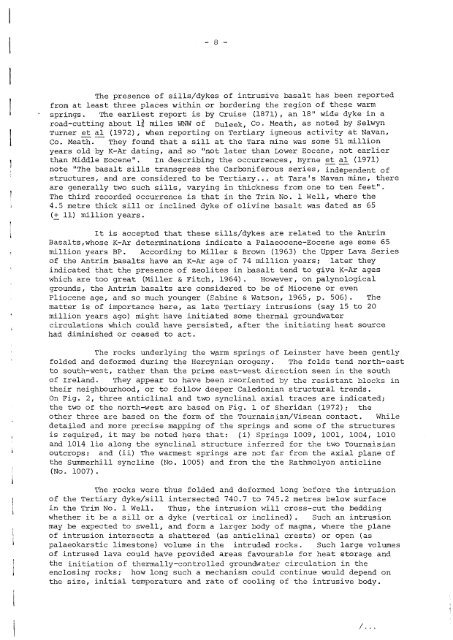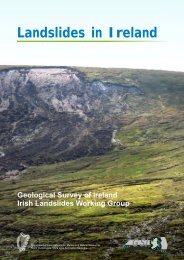Hydrogeothermal Conditions in Ãire - Geological Survey of Ireland
Hydrogeothermal Conditions in Ãire - Geological Survey of Ireland
Hydrogeothermal Conditions in Ãire - Geological Survey of Ireland
Create successful ePaper yourself
Turn your PDF publications into a flip-book with our unique Google optimized e-Paper software.
- 8 -The presence <strong>of</strong> sills/dykes <strong>of</strong> <strong>in</strong>trusive basalt has been reportedfrom at least three places with<strong>in</strong> or border<strong>in</strong>g the region <strong>of</strong> these warmspr<strong>in</strong>gs. The earliest report is by Cruise (1871), an 18" wide dyke <strong>in</strong> aroad-cutt<strong>in</strong>g about l~ miles WNW <strong>of</strong> Duleek, Co. Meath, as noted by SelwynTurner et al (1972), when report<strong>in</strong>g on Tertiary igneous activity at Navan,Co. Meath.-- They found that a sill at the Tara m<strong>in</strong>e was some 51 millionyears old by K-Ar dat<strong>in</strong>g, and so "not later than Lower Eocene, not earlierthan Middle Eocene". In describ<strong>in</strong>g the occurrences, Byrne et al (1971)note "The basalt sills transgress the Carboniferous series, <strong>in</strong>dependent <strong>of</strong>structures, and are considered to be Tertiary..• at Tara's Navan m<strong>in</strong>e, thereare generally two such sills, vary<strong>in</strong>g <strong>in</strong> thickness from one to ten feet".The third recorded occurrence is that <strong>in</strong> the Trim No. 1 Well, where the4.5 metre thick sill or <strong>in</strong>cl<strong>in</strong>ed dyke <strong>of</strong> oliv<strong>in</strong>e basalt was dated as 65(± 11) million years.It is accepted that these sills/dykes are related to the AntrimBasalts,whose K-Ar determ<strong>in</strong>ations <strong>in</strong>dicate a Palaeocene-Eocene age some 65million years BP. Accord<strong>in</strong>g to Miller & Brown (1963) the Upper Lava Series<strong>of</strong> the Antrim basalts have an K-Ar age <strong>of</strong> 74 million years; later they<strong>in</strong>dicated that the presence <strong>of</strong> zeolites <strong>in</strong> basalt tend to give K-Ar ageswhich are too great (Miller & Fitch, 1964). However, on palynologicalgrounds, the Antrim basalts are considered to be <strong>of</strong> Miocene or evenPliocene age, and so much younger (Sab<strong>in</strong>e & Watson, 1965, p. 506). Thematter is <strong>of</strong> importance here, as late Tertiary <strong>in</strong>trusions (say 15 to 20million years ago) might have <strong>in</strong>itiated some thermal groundwatercirculations which could have persisted, after the <strong>in</strong>itiat<strong>in</strong>g heat sourcehad dim<strong>in</strong>ished or ceased to act.The rocks underly<strong>in</strong>g the w~rm spr<strong>in</strong>gs <strong>of</strong> Le<strong>in</strong>ster have been gentlyfolded and deformed dur<strong>in</strong>g the Hercynian orogeny. The folds tend north-eastto south-west, rather than the prime east-west direction seen <strong>in</strong> the south<strong>of</strong> <strong>Ireland</strong>. They appear to have been reoriented by the resistant blocks <strong>in</strong>their neighbourhood, or to follow deeper Caledonian structural trends.On Fig. 2, three anticl<strong>in</strong>al and two syncl<strong>in</strong>al axial traces are <strong>in</strong>dicated;the two <strong>of</strong> the north-west are based on Fig. 1 <strong>of</strong> Sheridan (1972); theother three are based on the form <strong>of</strong> the Tournaisian/Visean contact. Whiledetailed and more precise mapp<strong>in</strong>g <strong>of</strong> the spr<strong>in</strong>gs and some <strong>of</strong> the structuresis required, it may be noted here that: (i) Spr<strong>in</strong>gs 1009, 1001, 1004, 1010and 1014 lie along the syncl<strong>in</strong>al structure <strong>in</strong>ferred for the two Tournaisianoutcrops: and (ii) The warmest spr<strong>in</strong>gs are not far from the axial plane <strong>of</strong>the Summerhill syncl<strong>in</strong>e (No. 1005) and from the the Rathmolyon anticl<strong>in</strong>e(No. 1007).The rocks were thus folded and deformed long before the <strong>in</strong>trusion<strong>of</strong> the Tertiary dyke/sill <strong>in</strong>tersected 740.7 to 745.2 metres below surface<strong>in</strong> the Trim No.1 Well. Thus, the <strong>in</strong>trusion will cross-cut the bedd<strong>in</strong>gwhether it be a sill or a dyke (vertical or <strong>in</strong>cl<strong>in</strong>ed) . Such an <strong>in</strong>trusionmay be expected to swell, and form a larger body <strong>of</strong> magma, where the plane<strong>of</strong> <strong>in</strong>trusion <strong>in</strong>tersects a shattered (as anticl<strong>in</strong>al crests) or open (aspalaeokarstic limestone) volume <strong>in</strong> the <strong>in</strong>truded rocks. Such large volumes<strong>of</strong> <strong>in</strong>trused lava could have provided areas favourable for heat storage andthe <strong>in</strong>itiation <strong>of</strong> thermally-controlled groundwater circulation <strong>in</strong> theenclos<strong>in</strong>g rocks; how long such a mechanism could cont<strong>in</strong>ue would depend onthe size, <strong>in</strong>itial temperature and rate <strong>of</strong> cool<strong>in</strong>g <strong>of</strong> the <strong>in</strong>trusive body./ ...
















